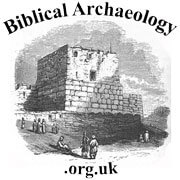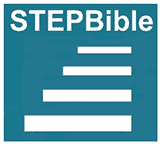 |
Robert Althann, "The impact of Ebla on biblical studies," Religion in Southern Africa 2.1 (Jan. 1981): 39-47. |
 |
Anonymous, "Ebla scholarship á la Syrienne: BAR reports on Damascus symposium," Biblical Archaeology Review 8.1 (1982): 54. |
 |
Alfonso Archi, "The epigraphic evidence from Ebla and the Old Testament," Biblica 60.4 (1979): 556-566. |
 |
Alfonso Archi, "Further concerning Ebla and the Bible," Biblical Archaeologist 44 (Summer 1981): 145-154. |
 |
Alfonso Archi, "Are "the cities of the plain" mentioned in the Ebla tablets: cities identified by Pettinato are nowhere near the Dead Sea," Biblical Archaeology Review 7.6 (1981): 54-55. |
 |
Alfonso Archi, "The "names and professions list": more fragments from Ebla," Revue d'Assyriologie et d'archéologie orientale 78.2 (1984): 171-174. |
 |
Alfonso Archi, "Mardu in the Ebla tablets," Orientalia ns 54.1-2 (1985): 7-13. Aage Westenholz, "An essay on the Sumerian "lexical" texts of the 3d millennium," Orientalia ns 54.1-2 (1985): 294-298. |
 |
Alfonso Archi, "The archives of Ebla," Cuneiform archives and libraries. Leiden: Nederlands Instituut voor het Nabije Oosten, 1986. pp.72-86. |
 |
Alfonso Archi, "More on Ebla and Kish," Eblaitica. Winona Lake, IN: Eisenbrauns, 1987. pp.125-140. |
 |
Alfonso Archi, "Position of the tablets of Ebla," Orientalia ns 57.1 (1988): 67-69. |
 |
Alfonso Archi, "Harran in the III millennium BC," Ugarit-Forschungen 20 (1988): 1-8. |
 |
Alfonso Archi, "Transmission of the Mesopotamian lexical and literary texts," Literature and literary language at Ebla. Florence: Dipartimento di linguistica, Université di Firenze, 1992. pp.1-40. |
 |
Alfonso Archi, "How a pantheon forms: the cases of Hattian-Hittite Anatolia and Ebla of the 3rd millennium BC," Religionsgeschichtliche Beziehungen zwischen Kleinasien, Nordsyrien und dem Alten Testament. Fribourg, Switzerland: Universitõtsverlag Freiburg Schweiz; Göttingen: Vandenhoeck & Ruprecht, 1993. pp.1-18. |
 |
Alfonso Archi, "Studies in the Pantheon of Ebla," Orientalia ns 63.3 (1994): 249-256. |
 |
Alfonso Archi, "Udua (LAK-777) and Uzu (LAK-350) in the Ebla texts," Cinquante-deux reflexions sur le Proche-Orient ancien. Louvain: Peeters, 1994. pp.321-327. |
 |
Alfonso Archi, "Salas consort of Dagan and Kumarbi," Studio historiae ardens. Istanbul: Nederlands Historisch-Archaeologisch Instituut, 1995. pp.1-6. |
 |
Alfonso Archi, "Two heads for the king of Ebla," Boundaries of the ancient Near Eastern world. Sheffield: Sheffield Academic Press, 1998. pp.386-396. |
 |
Alfonso Archi, "The high priestess, dam-dinger, at Ebla," "Und Mose schrieb dieses Lied auf" Münster: Ugarit-Verlag, 1998. pp.43-53. |
 |
Alfonso Archi, "Clothes in Ebla," Michael. Jaffa: Archaeological Center Publications, 1999. pp.45-54. |
 |
Alfonso Archi, "SES-II-IB: a religious confraternity." Eblaitica V 4,. Winona Lake, IN: Eisenbrauns, 2002. pp.23-55. |
 |
Alfonso Archi, "The head of Kura--the head of Adabal," Journal of Near Eastern Studies 64.2 (April 2005): 81-100. |
 |
Alfonso Archi & Maria Giovanna Biga, "A victory over Mari and the fall of Ebla," Journal of Cuneiform Studies 55 (2003): 1-44. Pelio Fronzaroli, "The hail incantation (ARET 5, 4)," Festschrift für Burkhart Kienast. Münster: Ugarit-Verlag, 2003. pp.89-107. |
 |
Pinhas Artzi, "In search of just retribution in law: new data from ancient Near Eastern sources," Occident and Orient. Budapest: AkadÚmiai Kiadó; Leiden: Brill, 1988 pp.13-20. |
 |
Pinhas Artzi, "Ebla and us," Michael. Jaffa: Archaeological Center Publications, 1999. pp.55-67. |
 |
E. Ascalone & Luca Peyronel, "Two weights from temple N at Tell Mardikh-Ebla, Syria: a link between metrology and cultic activities in the second millennium BC?" Journal of Cuneiform Studies 53 (2001): 1-12. |
 |
Maria Giovanna Biga (Silvano Votto, Translator), "The reconstruction of a relative chronology for the Ebla texts," Orientalia ns 72.4 (2003): 345-367. |
 |
Robert Biggs, "The Ebla tablets: an interim perspective," Biblical Archaeologist 43 (Spring 1980): 76-87. |
 |
Giorgio Buccellati, "Ebla and the Amorites," Eblaitica. Winona Lake, IN: Eisenbrauns, 1992. pp.83-104. |
 |
Ross Buckman, "A major new discovery in Canaan: royal Ebla," St Mark's Review no 98 (June 1979): 49-55. |
 |
Miguel Civil, "Studies on Early Dynastic lexicography III," Orientalia ns 56.3 (1987): 233-244. |
 |
Mitchell Joseph Dahood, "Ebla, Ugarit and the Old Testament," Congress volume. Leiden: Brill, 1978. pp.81-112. |
 |
Mitchell Joseph Dahood, "Ebla, Genesis and John," Christian Century 98 (April 15 1981): 418-421. |
 |
Mitchell Joseph Dahood, "Eblaite ì-du and Hebrew 'ed, "rain cloud"," Catholic Biblical Quarterly 43 (Oct. 1981): 534-538. |
 |
Mitchell Joseph Dahood, "The god Ya at Ebla," Journal of Biblical Literature 100 (Dec. 1981): 607-608. |
 |
Mitchell Joseph Dahood, "Ebla, Ugarit and Phoenician religion," Religione fenicia. Rome: Consiglio Nationale delle Ricerche, 1981. pp.45-57. |
 |
Mitchell Joseph Dahood, "Eblaite and Biblical Hebrew," Catholic Biblical Quarterly 44 (Jan. 1982): 1-24. |
 |
Mitchell Joseph Dahood, "The temple and other sacred places in the Ebla Tablets," Temple in Antiquity. Provo, Utah: Brigham Young University, 1984. pp.77-89. |
 |
John J. Davis, "Genesis: Archaeology - unraveling the truth about the patriarchs," Fundamentalist Journal 5.4 (April 1986): 18-19. pdf pdf |
 |
David Noel Freedman, "Real story of the Ebla Tablets: Ebla and the cities of the plain," Biblical Archaeologist 41 (Dec. 1978): 143-164. |
 |
David Noel Freedman, "'Epigraphic evidence from Ebla': A correction," Biblica 62.1 (1981): 103. |
 |
David Noel Freedman, "Freedman replies to Pettinato on Ebla checking," Biblical Archaeology Review 7.2 (Mar.-April 1981): 19-20. |
 |
David Noel Freedman, "Ebla and the Old Testament," Studies in the period of David and Solomon and other essays Int'l Symposium for Biblical Studies, Tokyo, 1979. Winona Lake, IN: Eisenbrauns, 1982. pp.309-335. |
 |
Pelio Fronzaroli, "West Semitic toponymy in northern Syria in the third millennium BC," Journal of Semitic Studies 22 (Autumn 1977): 145-166. |
 |
Pelio Fronzaroli, "The concord in gender in Eblaite theophoric personal names," Ugarit-Forschungen 11 (1980): 275-281. |
 |
Pelio Fronzaroli, "The ritual texts of Ebla," Literature and literary language at Ebla. Florence: Dipartimento di linguistica, Université di Firenze, 1992. pp.163-185. |
 |
Markham J. Geller, "The lugal of Mari at Ebla and the Sumerian king list," Eblaitica. Winona Lake, IN: Eisenbrauns, 1987. pp.141-145. |
 |
William W. Hallo, "The Syrian contribution to cuneiform literature," New horizons in the study of ancient Syria. Malibu: Undena, 1992. pp.69-88. |
 |
Cyrus Herzl Gordon, "Ebla and Genesis 11," Spectrum of Thought. Wilmore, KY: Francis Asbury Publishing Co, 1982. pp.125-134. |
 |
Cyrus Herzl Gordon, "Hby, possessor of horns and tail," Ugarit-Forschungen 18 (1986): 129-132. |
 |
Cyrus Herzl Gordon, "Ebla as background for the Old Testament," Congress volume. Leiden : E J Brill, 1988. pp.293-297. |
 |
Cyrus Herzl Gordon, "The geographical horizons of Ebla," New horizons in the study of ancient Syria. Malibu: Undena, 1992. pp.63-68. |
 |
Cyrus Herzl Gordon & Gary A. Rendsburg & Nathan H. Winter, eds., Eblaitica: essays on the Ebla archives and Eblaite language, vol 1. Winona Lake, IN: Eisenbrauns, 1987. pp.145. |
 |
Cyrus Herzl Gordon, "The Ebla Incantations and Their Affinities with Northwest Semitic Magic," Maarav 7 (1991): 117-129. |
 |
Cyrus Herzl Gordon, "The Ebla exorcisms," Eblaitica. Winona Lake, IN: Eisenbrauns, 1992. pp.127-137. |
 |
Cyrus Herzl Gordon & Gary A. Rendsburg, eds., Eblaitica: essays on the Ebla archives and Eblaite language, vol 3. Winona Lake, IN: Eisenbrauns, 1992. pp.ix + 158. |
 |
Cyrus Herzl Gordon & Gary A. Rendsburg, eds., "Eblaitica: essays on the Ebla archives and Eblaite language, V 4," Publications of the Center for Ebla Research at New York University. Winona Lake, IN: Eisenbrauns, 2002. pp.xvi + 269. |
 |
Roland K. Harrison, "The
Ancient Kingdom of Ebla," Faith and Thought 104.1 (1977): 45-48. pdf [Reproduced by permission of the current copyright holder] pdf [Reproduced by permission of the current copyright holder] |
 |
Willem C. van Hattem, "Once again: Sodom and Gomorrah," Biblical Archaeologist 44 (Spring 1981): 87-92. |
 |
John F. Healey, "Keeping up with recent studies, 8: Ebla: ancient city of Syria," Expository Times 91 (Aug. 1980): 324-328. |
 |
John F. Healey, "The immortality of the king: Ugarit and the Psalms," Orientalia ns 53.2 (1984): 245-254. |
 |
Karola Kautz, "On chronology," Biblical Archaeologist 44 (Winter 1981): 5-6. Mitchell Joseph Dahood, "The first Ebla congress," Biblical Archaeologist 44 (Winter 1981): 63. |
 |
J. Kilian, "Ebla: an empire inscribed in clay," Theologia Evangelica 17.2 (June 1984): 26-32. |
 |
Joachim Krecher, "UD.GAL.NUN versus "normal" Sumerian : two literatures or one?" Literature and literary language at Ebla. Florence: Dipartimento di linguistica, Università di Firenze, 1992. pp.285-303. |
 |
Joachim Krecher, "The Ebla tablets and their possible significance for biblical studies," Biblical Archaeology Ttoday, 1990. Jerusalem: Israel Exploration Society, 1993. pp.498-507. |
 |
William Sanford La Sor, "Major archaeological discoveries at Tell Mardikh," Christianity Today 20 (Sept. 24 1976): 49. |
 |
William
Sanford La Sor, "Further information about Tell Mardikh," Journal of the
Evangelical Theological Society 19.4 (Fall 1976): 265-270.  pdf pdf |
 |
William Sanford La Sor, "Tell Mardikh - the latest archeological "greatest"," Theology News & Notes 23 (Dec. 1976): 19-23. |
 |
Wilfred G. Lambert, "Notes on a work of the most ancient Semitic literature," Journal of Cuneiform Studies 41 (Spring 1989): 1-33. |
 |
Dennis J. McCarthy, "Ebla, horchia temnein, tb, slm: addenda to Treaty and covenant," Biblica 60.2 (1979): 247-253. |
 |
Pietro Mander, "Sumerian personal names in Ebla," Journal of the American Oriental Society 108 (July-Sept. 1988): 481-483. |
 |
Nicolò Marchetti & Lorenzo Nigro, "Cultic Activities in the Sacred Area of Ishtar at Ebla During the Old Syrian Period: The Favissae F.5327 and F.5238," Journal of Cuneiform Studies 49 (1997): 1-44. |
 |
Paolo Matthiae, "Ebla in the late early Syrian period : the royal palace and the state archives," Biblical Archaeologist 39 (Sept. 1976): 94-113. |
 |
Paolo Matthiae, "Some fragments of early Syrian sculpture from royal palace G of Tell Mardikh-Ebla," Journal of Near Eastern Studies 39.4 (1980): 249-273. |
 |
Paolo Matthiae, "Princely cemetery and ancestors cult at Ebla during middle Bronze II: a proposal of interpretation," Ugarit-Forschungen 11 (1980): 563-569. |
 |
Paolo Matthiae, "The Ebla debate / by Matthiae, Paolo...[et al.]," Biblical Archaeologist 44 (Summer 1981): 137. |
 |
Paolo Matthiae, "New discoveries at Ebla: the excavation of the western palace and the royal necropolis of the Amorite period," Biblical Archaeologist 47 (March 1984): 18-32. |
 |
Paolo Matthiae, "The archives of the Royal Palace G of Ebla: distribution and arrangement of the tablets according to the archaeological evidence," Cuneiform archives and libraries. Leiden: Nederlands Instituut voor het Nabije Oosten, 1986. pp.53-71. |
 |
Paolo Matthiae, "Old Syrian ancestors of some Neo-Assyrian figurative symbols of kingship," Archaeologia Iranica et Orientalis. Ghent: Peeters, 1989. pp.367-391. |
 |
Paolo Matthiae, "A class of Old Syrian bronze statuettes and the sanctuary B2 at Ebla," Resurrecting the Past. Istanbul: Nederlands Historisch-Archaeologisch Instituut, 1990. pp.345-362. |
 |
Paolo Matthiae, "A stele fragment of Hadad from Ebla," Aspects of Art and Iconography. Ankara: Türk Tarih Kurumu Basimevi, 1993. pp.389-397. |
 |
Paolo Matthiae, "The lions of the Great Goddess of Ebla: a hypothesis about some archaic Old Syrian cylinders," Cinquante-deux reflexions sur le Proche-Orient ancien. Louvain: Peeters, 1994. pp.329-338. |
 |
Stefania Mazzoni, "Elements of the ceramic culture of Early Syrian Ebla in comparison with Syro-Palestinian EB IV," Bulletin of the American Schools of Oriental Research no 257 (Winter 1985): 1-18. |
 |
Stefania Mazzoni, "Observations about Iron Age glyptics from Tell Afis and Tell Mardikh," Resurrecting the past. Istanbul: Nederlands Historisch-Archaeologisch Instituut, 1990. pp.215-226. |
 |
Stefania Mazzoni, "Ebla: crafts and power in an emergent state of the third millennium BC Syria," Journal of Mediterranean Archaeology 16.2 (Dec. 2003): 173-191. |
 |
Eugene H.
Merrill, "Ebla and biblical historical inerrancy," Bibliotheca Sacra 140
(Oct.-Dec. 1983): 302-321.  pdf [Reproduced by permission of the current copyright holder] pdf [Reproduced by permission of the current copyright holder] |
 |
Piotr Michalowski, "Third millennium contacts: observations on the relationships between Mari and Ebla," Journal of the American Oriental Society 105.2 (April-June 1985): 293-302. |
 |
Piotr Michalowski, "Mari: the view from Ebla," Mari in Retrospect. Winona Lake, IN: Eisenbrauns, 1992. pp.243-248. |
 |
Lucio Milano, "Ebla: a third-millennium city-state in ancient Syria," Civilizations of the ancient Near East, vol 2. New York: Charles Scribner's Sons, 1995. pp.1219-1230. |
 |
Alan R. Millard, "Ebla and the Bible: what's left (if anything)?" Bible Review 8 (April 1992): 18-31, 60, 62. |
 |
James D. Muhly, "Ur and Jerusalem not mentioned in Ebla tablets, say Ebla expedition scholars," Biblical Archaeology Review 9.6 (Nov.-Dec. 1983): 74-75. |
 |
L.M. Muntingh, "Second thoughts on Ebla and the Old Testament," Text and Context. Sheffield: Journal for the Study of the Old Testament Press, 1988. pp.157-175. |
 |
Anne C. Ogilvy, "Interview: Paolo Matthiae and Gabriela Matthiae Scandone," Biblical Archaeologist 39 (Sept. 1976): 90-93. |
 |
Frances Pinnock, "The urban landscape of old Syrian Ebla," Journal of Cuneiform Studies 53 (2001): 13-33. |
 |
Francesco Pomponio, "Notes on the lexical texts from Abu Salabikh and Ebla," Journal of Near Eastern Studies 42.4 (Oct. 1983): 285-290. |
 |
Francesco Pomponio, "The Transfer of Decorative Objects and the Reading of the Sign DU in the Ebla Documentation," Journal of Near Eastern Studies 57 (Jan. 1998): 29-39. |
 |
Giovanni Pettinato, "Royal archives of Tell Mardikh-Ebla," Biblical Archaeologist 39 (May 1976): 44-52. |
 |
Giovanni Pettinato, "Ebla and the Bible," Biblical Archaeologist 43 (Fall 1980): 203-216. |
 |
Wayne T. Pitard, "The meaning of EN at Ebla," Crossing boundaries and linking horizons. Bethesda, MD: CDL Press, 1997. pp.399-416. |
 |
Wayne T. Pitard, "Tombs and offerings: archaeological data and comparative methodology in the study of death in Israel," Sacred time, sacred place. Winona Lake, IN: Eisenbrauns, 2002. pp.145-167. |
 |
J.J.M. Roberts, "The ancient Near Eastern environment," Hebrew Bible and its Modern Interpreters. Philadelphia, PA: Fortress Press, 1985. pp.75-121. |
 |
K.S.B. Ryholt, "Hotepibre, a Supposed Asiatic King in Egypt with Relations to Ebla," Bulletin of the American Schools of Oriental Research no 311 (Aug. 1998): 1-6. |
 |
R. Thomas Schaub, "Revolutionary discoveries at Tell Mardikh," Thesis Theological Cassettes 8.5 (June 1977). |
 |
Brian B. Schmidt, "A re-evaluation of the Ugaritic king list (KTU 1:113)," Ugarit, Religion and Culture. Münster: Ugarit-Verlag, 1996. pp.289-304. |
 |
William H. Shea, "The Calendars of Ebla, pt 1: the old calendar," Andrews University Seminary Studies 18.2 (Autumn 1980): 127-137. pdf pdf |
 |
William H. Shea, "The calendars of Ebla, pt 2: the new calendar." Andrews University Seminary Studies 19.1 (Spring 1981): 59-69. pdf pdf |
 |
William H. Shea, "The Calendars of Ebla pt 3: Conclusion," Andrews University Seminary Studies 19.2 (Summer 1981): 115-126. pdf pdf |
 |
Clyde C. Smith, "Birth of bureaucracy," Biblical Archaeologist 40 (March 1977): 24-28. |
 |
Piotr Steinkeller, "Observations on the Sumerian personal names in Ebla sources and on the onomasticon of Mari and Kish," Tablet and the Scroll. Bethesda, MD: CDL Press, 1993. pp.236-245. |
 |
K. Arvid Tängberg, "Eblaite: an introduction to the state of research on the cuneiform tablets of Ebla," SJOT 2 (1987): 111-120. |
 |
Lorenzo Viganò, "Literary sources for the history of Palestine and Syria : the Ebla tablets," Biblical Archaeologist 47 (March 1984): 6-16. |
 |
Lorenzo Viganò, "Judges at Ebla," Liber annuus 41 (1991): 303-310. Cyrus Herzl Gordon, "New directions in the study of ancient Middle Eastern cultures," Near Eastern studies dedicated to H I H Prince Takahito Mikasa on the occasion of his seventy-fifth birthday. Wiesbaden: Otto Harrassowitz, 1991. pp.53-65. |
 |
Lorenzo Viganò, "Mari and Ebla: of time and rulers," Liber annuus 44 (1994): 351-373. |
 |
Lorenzo Viganò, "Rituals at Ebla," Journal of Near Eastern Studies 54 (July 1995): 215-222. |
 |
Lorenzo Viganò, "The use of the Sumerian word níg-ba, "gift" in the Ebla administrative reports," Liber annuus 45 (1995): 203-215. |
 |
Lorenzo Viganò, "Rituals at Ebla II, ì-gis sag: A Purification Ritual or Anointing of the Head?" Journal of Near Eastern Studies 59.1 (Jan. 2000): 13-22. |
 |
Saul N. Vitkus, "Sargon unseated," Biblical Archaeologist 39 (Sept. 1976): 114-117. |
 |
Walter Wifall, "Preliminary report on Ebla," Biblical Theology Bulletin 7 (April 1977): 89-91. |
 |
Edwin M. Yamauchi, "Unearthing Ebla's ancient secrets," Christianity Today 25 (May 8 1981): 18-21. |
 |
Ida Zatelli, "The Origin of the Biblical Scapegoat Ritual: The Evidence of the Two Eblaite Texts," Vetus Testamentum 48.2 (April 1998): 254-263. |










